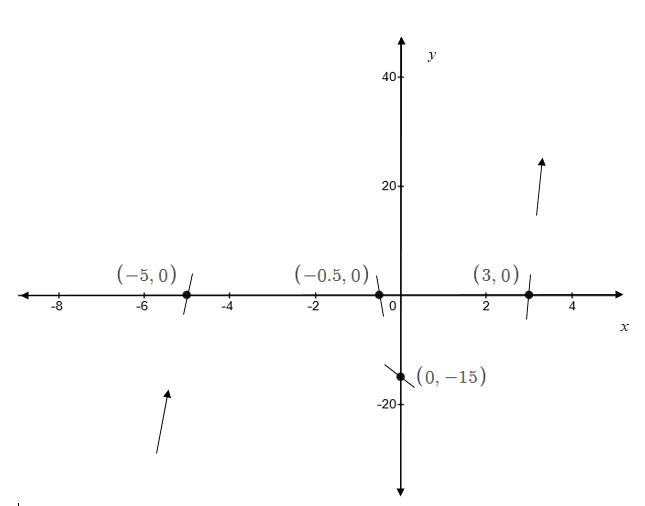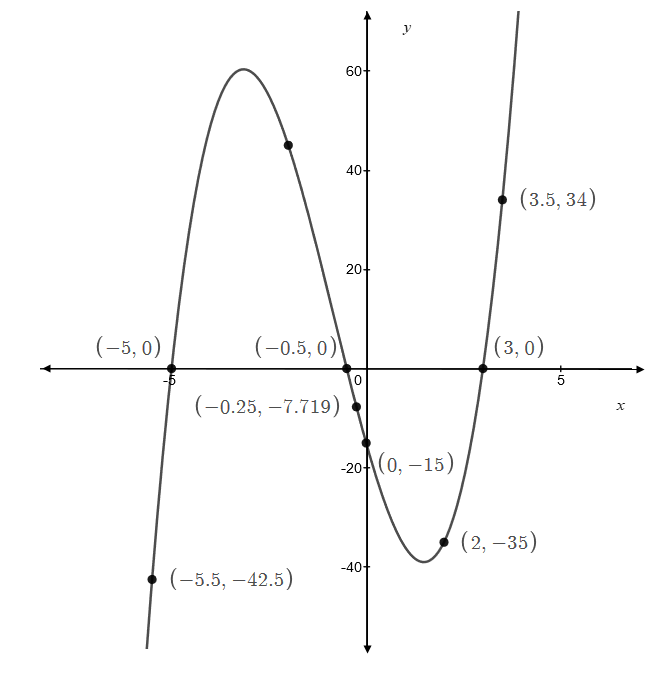
Concept explainers
For the polynomial function
Determine the maximum number of real zeros that the function may have.
List the potential rational zeros.
Determine the real zeros of
Find the
Determine whether the graph crosses or touches the x –axis at each x –intercept.
Find the power function that the graph of
Put all the information together to obtain the graph of
(a)
The maximum number of real zeros of the function
Answer to Problem 2CT
Solution:
The maximum number of real zeros of
Explanation of Solution
Given Information:
The function,
Let, the function
The maximum number of real zeros is the degree of the polynomial.
Here, the degree of
Therefore, the maximum number of real zeros of
(b)
The list of potential rational zeros of the function
Answer to Problem 2CT
Solution:
The list of potential zeros of
Explanation of Solution
Given Information:
The function,
Let, the function
Now, to list the potential rational zeros of
By rational root theorem,
The divisors of the constant term are
The divisors of the leading coefficient are
Then, possible rational zeros of the polynomial are,
Therefore, the list of potential zeros of
(c)
The real zeros of
Answer to Problem 2CT
Solution:
The real zeros of
Explanation of Solution
Given Information:
The function,
Let, the function
From part (b),
The potential rational zeros of
Now, test
Here, since the remainder is 0,
After taking
Then, the depressed equation is,
By quadratic formula;
The factors of
The factor form of
Hence, the real zeros of
(d)
The
Answer to Problem 2CT
Solution:
The
Explanation of Solution
Given Information:
The function,
To find
Thus the
Now to find
Hence the
(e)
Whether the graph crosses or touches the
Answer to Problem 2CT
Solution:
Thegraph crosses the
Explanation of Solution
Given Information:
The function,
From part (c) the factors of the function
3 is the zero of the function with multiplicity 1 since the exponent of the factor
The graph of the function
(f)
The power function that the graph of
Answer to Problem 2CT
Solution:
Thegraph of the function
Explanation of Solution
Given Information:
The function,
The polynomial function is
Here the degree of the polynomial function
The graph of the function
(g)
To graph: The function,
Explanation of Solution
Given Information:
The function,
Graph:
The polynomial function is
From all the above parts, the analysis of the function
The graph of the function
Thezeros of the function are
The
Thegraph crosses the
Here the degree of the polynomial function
Using all these information, the graph will look alike:

Now find additional points on the graph on each side of
For
For
For
For
For
Now plot all these coordinates
So the graph of the function is as follows,

Interpretation:
The graph of the function
The
Thegraph crosses the
Here the degree of the polynomial function
Chapter 4 Solutions
Precalculus
Additional Math Textbook Solutions
Elementary Statistics: Picturing the World (7th Edition)
Calculus: Early Transcendentals (2nd Edition)
Pre-Algebra Student Edition
Elementary Statistics (13th Edition)
University Calculus: Early Transcendentals (4th Edition)
- Calculus III May I please have some elaborations on Example 2 part a? Thank you.arrow_forward1. A bicyclist is riding their bike along the Chicago Lakefront Trail. The velocity (in feet per second) of the bicyclist is recorded below. Use (a) Simpson's Rule, and (b) the Trapezoidal Rule to estimate the total distance the bicyclist traveled during the 8-second period. t 0 2 4 6 8 V 10 15 12 10 16 2. Find the midpoint rule approximation for (a) n = 4 +5 x²dx using n subintervals. 1° 2 (b) n = 8 36 32 28 36 32 28 24 24 20 20 16 16 12 8- 4 1 2 3 4 5 6 12 8 4 1 2 3 4 5 6arrow_forward= 5 37 A 4 8 0.5 06 9arrow_forward
- Consider the following system of equations, Ax=b : x+2y+3z - w = 2 2x4z2w = 3 -x+6y+17z7w = 0 -9x-2y+13z7w = -14 a. Find the solution to the system. Write it as a parametric equation. You can use a computer to do the row reduction. b. What is a geometric description of the solution? Explain how you know. c. Write the solution in vector form? d. What is the solution to the homogeneous system, Ax=0?arrow_forward2. Find a matrix A with the following qualities a. A is 3 x 3. b. The matrix A is not lower triangular and is not upper triangular. c. At least one value in each row is not a 1, 2,-1, -2, or 0 d. A is invertible.arrow_forwardFind the exact area inside r=2sin(2\theta ) and outside r=\sqrt(3)arrow_forward
- A 20 foot ladder rests on level ground; its head (top) is against a vertical wall. The bottom of the ladder begins by being 12 feet from the wall but begins moving away at the rate of 0.1 feet per second. At what rate is the top of the ladder slipping down the wall? You may use a calculator.arrow_forwardExplain the focus and reasons for establishment of 12.4.1(root test) and 12.4.2(ratio test)arrow_forwarduse Integration by Parts to derive 12.6.1arrow_forward
- Explain the relationship between 12.3.6, (case A of 12.3.6) and 12.3.7arrow_forwardExplain the key points and reasons for the establishment of 12.3.2(integral Test)arrow_forwardUse 12.4.2 to determine whether the infinite series on the right side of equation 12.6.5, 12.6.6 and 12.6.7 converges for every real number x.arrow_forward
 Calculus: Early TranscendentalsCalculusISBN:9781285741550Author:James StewartPublisher:Cengage Learning
Calculus: Early TranscendentalsCalculusISBN:9781285741550Author:James StewartPublisher:Cengage Learning Thomas' Calculus (14th Edition)CalculusISBN:9780134438986Author:Joel R. Hass, Christopher E. Heil, Maurice D. WeirPublisher:PEARSON
Thomas' Calculus (14th Edition)CalculusISBN:9780134438986Author:Joel R. Hass, Christopher E. Heil, Maurice D. WeirPublisher:PEARSON Calculus: Early Transcendentals (3rd Edition)CalculusISBN:9780134763644Author:William L. Briggs, Lyle Cochran, Bernard Gillett, Eric SchulzPublisher:PEARSON
Calculus: Early Transcendentals (3rd Edition)CalculusISBN:9780134763644Author:William L. Briggs, Lyle Cochran, Bernard Gillett, Eric SchulzPublisher:PEARSON Calculus: Early TranscendentalsCalculusISBN:9781319050740Author:Jon Rogawski, Colin Adams, Robert FranzosaPublisher:W. H. Freeman
Calculus: Early TranscendentalsCalculusISBN:9781319050740Author:Jon Rogawski, Colin Adams, Robert FranzosaPublisher:W. H. Freeman
 Calculus: Early Transcendental FunctionsCalculusISBN:9781337552516Author:Ron Larson, Bruce H. EdwardsPublisher:Cengage Learning
Calculus: Early Transcendental FunctionsCalculusISBN:9781337552516Author:Ron Larson, Bruce H. EdwardsPublisher:Cengage Learning





